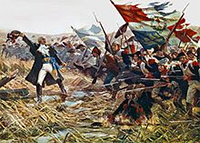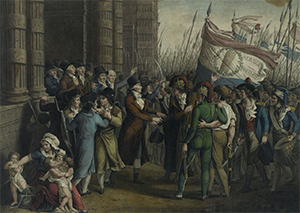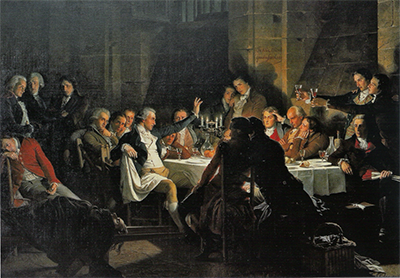The Girondins of France
The Girondins were one of two leading factions of political leaders during the French Revolution. More moderate than their main rivals (the Montagnards), the Girondins favored a republican government and were more than happy to go to war with other European nations in order to protect that government. The Girondins ran the government for a time but fell victim to Montagnard intrigue and violence in the end. 
The name came from the fact that many of the well-known members of the group were from the Gironde, an area in the southwest of the country. They were also known as Brissotists, after their most prominent member, the writer Jacques Pierre Brissot (right). Other well-known Girondins included Nicolas de Bonneville, Étienne Clavière, the Marquis de Condorcet, Claude Fauchet, Jérome Pétion, and Jean Marie Roland. Three of that number served in government: Clavière as finance minister, Roland as interior minister, and Pétion as mayor of Paris. The Girondins and Montagnards both were members of the Jacobin Club, the most well-known of France's political clubs. The Girondins, who achieved much more of a solid voice and presence in government than did the Montagnards, later met at the The Girondins wanted the monarchy done away with, and a republic installed in its wake, but they preferred a measured approach, one imbued with the reasoned course of action set out by Jean-Jacques Rousseau and other philosophes, who championed a triumph of ideas over a stampede of reckless action. The Girondins wanted a referendum to decide the fate of the king; the Convention had other ideas. The Girondins were powerful orators who could sway other people with their words and their lofty ideals. They also favored war with Austria and Prussia, as a means of spreading the light of republicanism elsewhere in Europe. Opposing them on both of those counts were the Montagnards, who eventually gained the upper hand. The Girondins dominated both the Legislative Assembly and the National Convention, but it it was in the latter that they began to lose their influence. The war that so many Girondins and others had wanted to bring about began in early 1792. It did not go well. One significant change to military procedures as a result of the drive toward more equality–that officers be appointed according to ability rather than nobility–convinced many existing officers to join those leaving the country. Thus, when France declared war on Austria on April 20, 1792, it did so with a relatively new raft of officers. The same was true for the equivalent of the enlisted men. Many of the 164,000 soldiers who went to war with Austria were poorly trained and poorly equipped. They had talented, experienced commander in the Marquis de Lafayette and Jean-Baptiste Donatien de Vimeur, comte de Rochambeau, both of whom had seen combat during the American Revolutionary War. But the egalitarian nature of the Revolution led many soldiers to question even these seasoned commanders. As well, the French Army faced enemies from within. Queen Marie Antoinette was from Austria. She sought to prevent a complete elimination of the monarchy by embracing the efforts of Austria and others in restoring her husband to her former power; to do so, she obtained her army's war plans and passed them to the Austrian war department. 
One bright spot for French troops was their new battle hymn, Chant de guerre pour l'armée de Rhin ("War Song for the Rhine Army"), which Rouget de Lisle had recently. composed. Soldiers across the country sang it, but it became known as the song of a battlion from Marseille and so became La Marseilliaise (by which it is still known today). The war was not kind to France from the outset. One group of French soldiers fled the battlefield and fell on their own general instead, accusing him of treason and executing him on the spot. Other French forces went into battle but found defeat. Rochambeau resigned, and Lafayette did not survive a subsequent reorganization. A second French invasion, in June, had some success, capturing two towns. The result, however, was the growth of the force allied against them. The Duke of Brunswick issued the Brunswick Manifesto, which proclaimed that any harm inflicted on the French royal family would result in devastation of Paris. He then marched at the head of an allied force of Austrians, French émigrés, Hessians, and Prussians, into the heart of France, besieging Verdun and then marching on Paris. What looked like certain French defeat turned into something entirely different at Valmy, on Sept. 20, 1792. French artillery ruled the day, and the allied force retreated. The beleaguered allied force, far from home, retreated further, battling against dysentery and broken supply lines as well as an inspired force of French pursuers. French troops seized the Prussian city of Mainz in short order and, at the end of October, Frankfurt as well. Meanwhile, the landscape inside France had changed rapidly. In August, as French troops were regrouping, a crowd of radicals stormed the Tuileries Palace and seized the royal family, placing them in lockdown in the Square du Temple. The next month, on the same day that French guns had won a resounding victory at Valmy, the Legislative Assembly had transferred its lawmaking authority to the National Convention. Within two days, the Convention had abolished the monarchy and declared the French Republic. From this point, the Girondins were the more conservative of the group of republicans, as the Montagnards and others advanced more and more radical ideas. Also significant in September 1792 was a series of massacres of political prisoners who had opposed the Revolution. Girondins denounced such violence and blamed the Montagnards for endorsing it. Girondins led by Condorcet advanced a new constitution in the National Convention, unveiling a draft in March 1793. In the next few months, the Girondins lost their positions of power completely. In an effort to counter the Montagnards' ally the Paris Commune, the Girondins proposed to disband it. The response from both opposing entities was harsh. Also at this time elected mayor was Jean-Nicolas Pache, a onetime Girondin and former war minister who had been repudiated by the rest after a political scandal; Pache vowed to take his revenge on those who had turned him away. In April 1793, Girondins succeeded in having one of their most vocal critics, the Montagnard journalist Jean-Paul Marat arrested and sent before the Revolutionary Tribunal. Marat delivered a passionate defense and won acquittal, giving him even more prestige and influence and weakening the Girondins' hold on power further. In early 1793 as well, the war fortunes of the French army had turned for the worse again, and not only Montagnards but much of the populace at large blamed the Girondins for starting a war that they were not winning. The war was continuing to sap resources that a great many French people thought were more needed at home. 
The downfall of the Girondins came on May 31–June 2, 1793. A popular uprising by the Paris Commune and a large number of sans-culottes joined with a move of ouster by the Montagnards within the Convention, and the result was a purge of Girondins as Convention deputies and the arrest of dozens of them. The Montagnard takeover of the government was complete. Many Girondins escaped arrest and fled Paris, later joining in Caen in an effort to form a rebellion. Those who stayed or could not escape were tried and executed. On July 13, 1793, the Girondin sympathizer Charlotte Corday murdered Marat as he lay in his bath. Such an act of callous violence seemed to many people far worse than the kinds of the rioting and reprisals that the Montagnards had urged, and Girondin support plummeted. The Revolutionary Tribunal tried 22 Girondin former deputies and ordered the execution of all of them. Also executed were Corday and Madame Roland. The Reign of Terror ended with the execution of its most outspoken leader, Maximilien Robespierre, on July 28, 1794. What remained of the Girondins, for the most part, were content to keep out of politics from then on. A handful did return to the national Convention, in March 1795.
|
|
Social Studies for Kids
copyright 2002–2025
David White



 salon of Marie-Jeanne Roland, wife of Jean-Marie. Because of this cohesion, they were the ruling faction within the various legislative bodies for a few years during the middle stages of the Revolution.
salon of Marie-Jeanne Roland, wife of Jean-Marie. Because of this cohesion, they were the ruling faction within the various legislative bodies for a few years during the middle stages of the Revolution.
